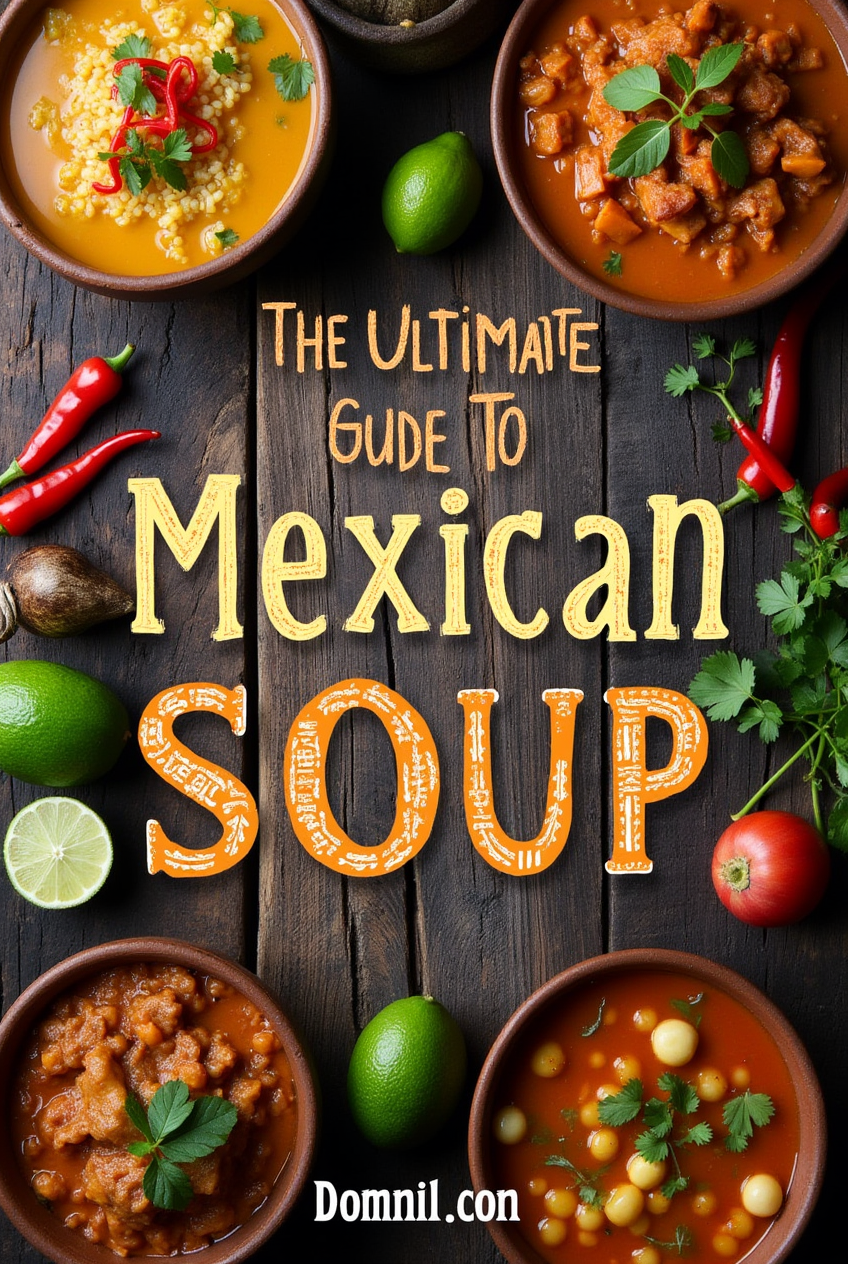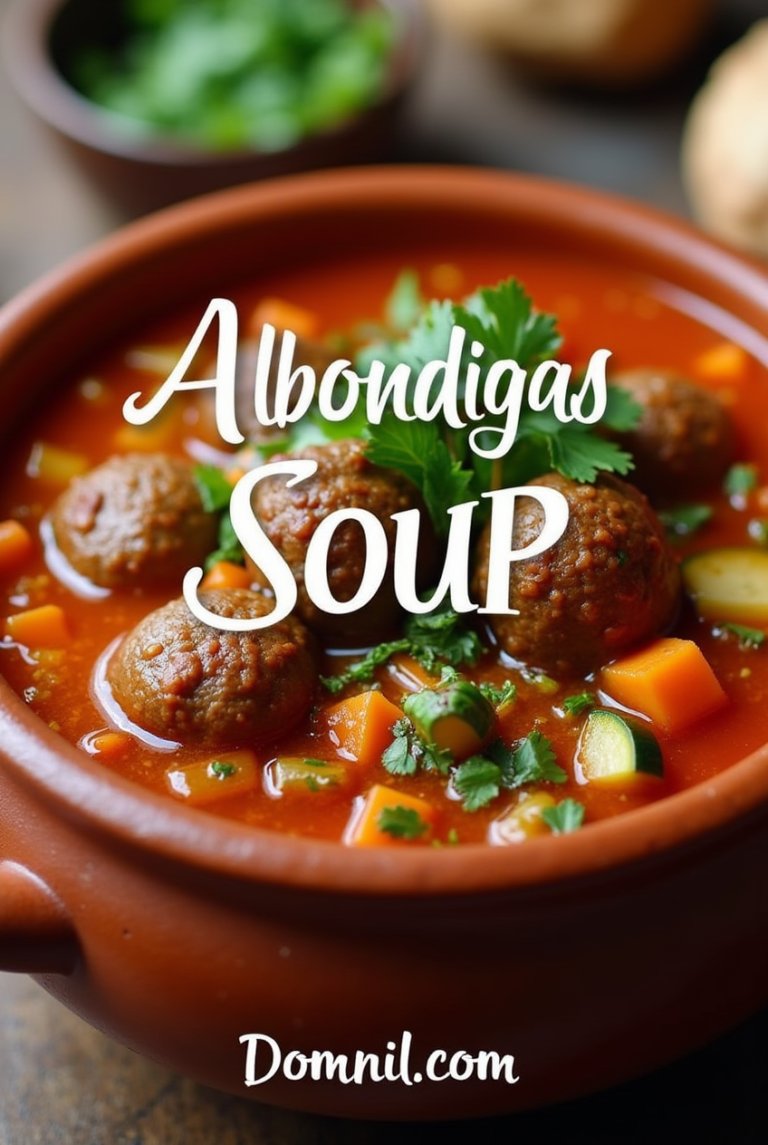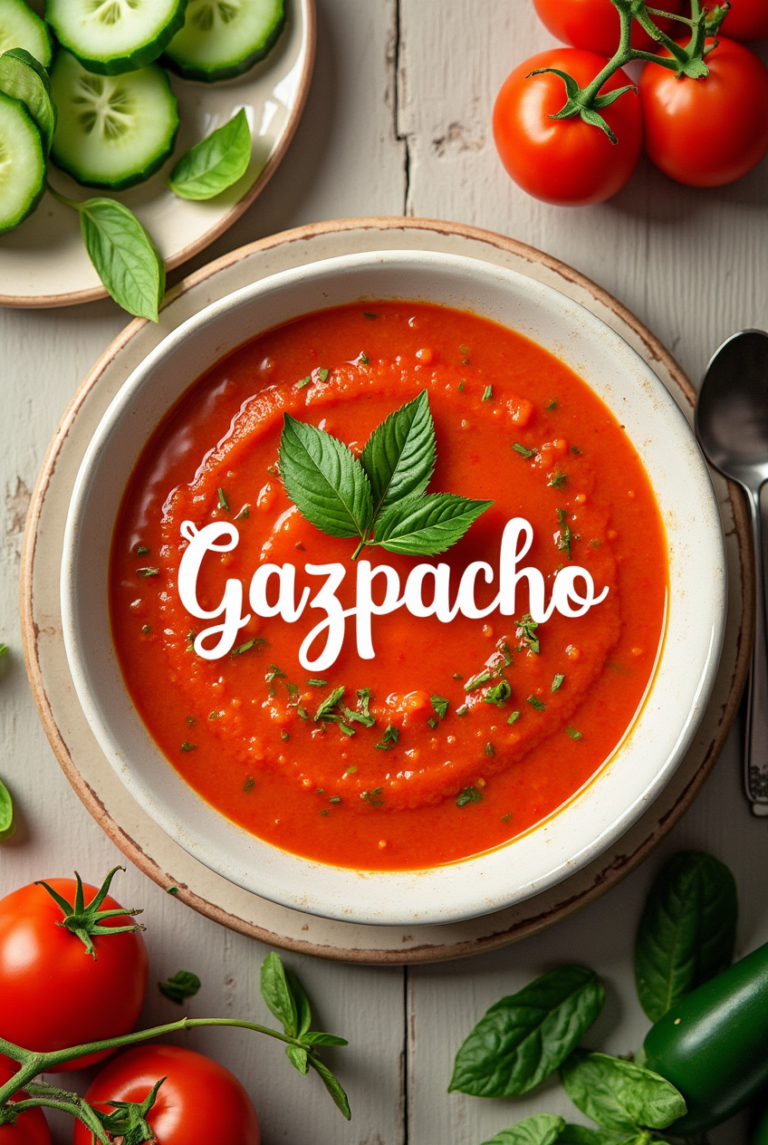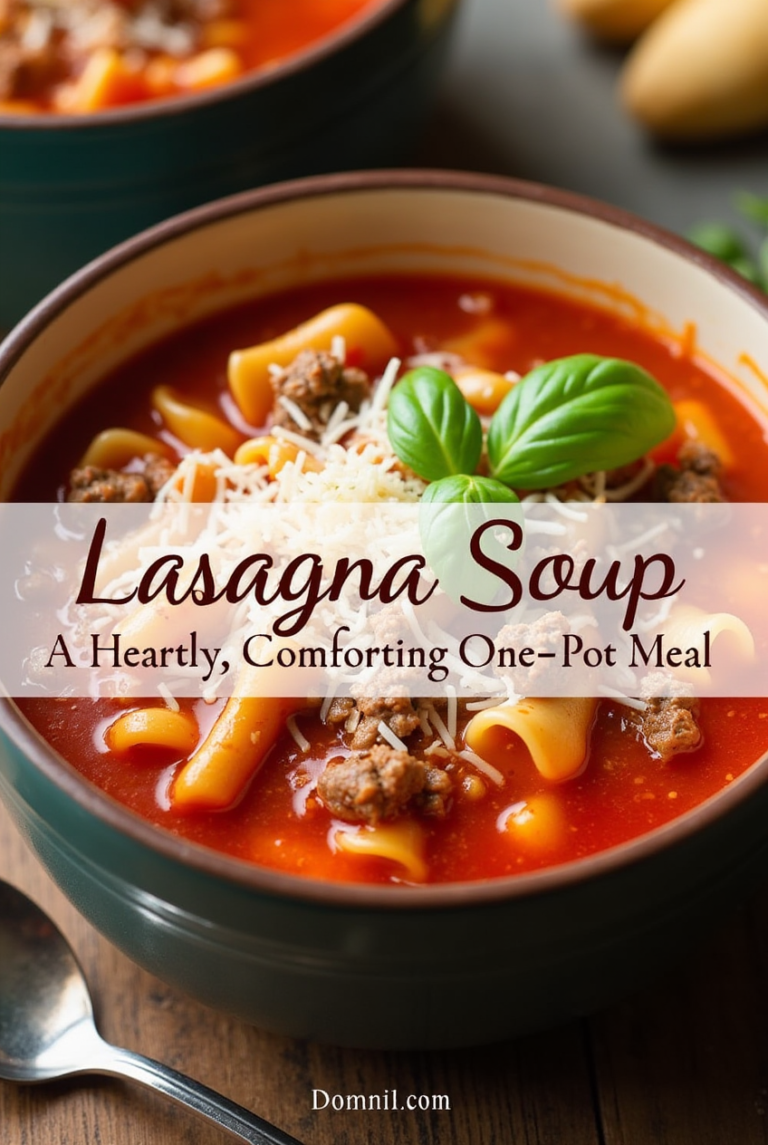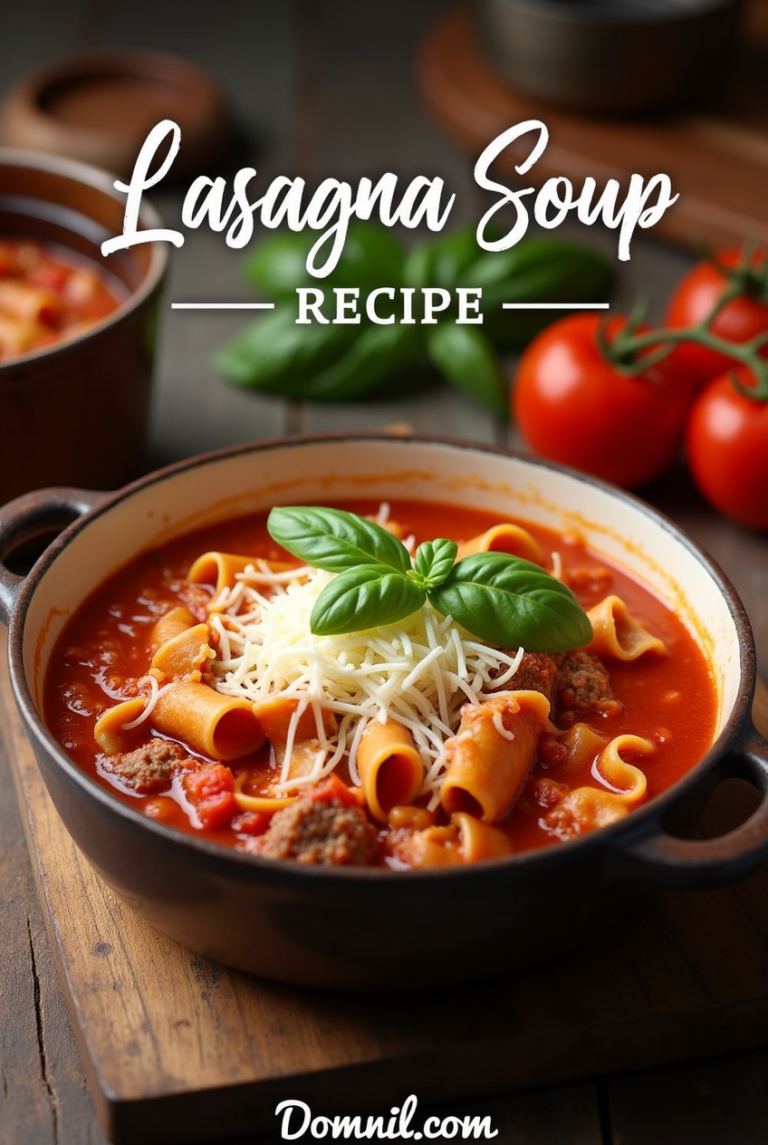Discover Mexican Soups: Bold Flavors, Generational Wisdom and Captivating Food Stories
Introduction to Mexican Soup
Why Mexican Soup Deserves a Spotlight
Let’s be real—when most people think about Mexican cuisine, tacos, burritos, and enchiladas steal the spotlight. But if you’ve ever dipped a spoon into a steaming bowl of pozole or tasted the rich broth of a hearty caldo de res, you’ll know Mexican soups are the real unsung heroes. These aren’t your average throw-it-in-a-pot-and-boil type of meals. Mexican soups are steeped in centuries-old traditions, loaded with robust spices, and crafted with love and patience that tell a story with every bite.
One reason Mexican soups are so special? They’re not just about flavor—they’re about experience. From gathering around a pot simmering with menudo during a Sunday brunch to sipping on tortilla soup during cool evenings, these soups bring people together. And they don’t just warm your stomach; they warm your soul. These are dishes that go beyond food—they’re part of rituals, hangover cures, religious festivals, and family traditions passed down like precious heirlooms.
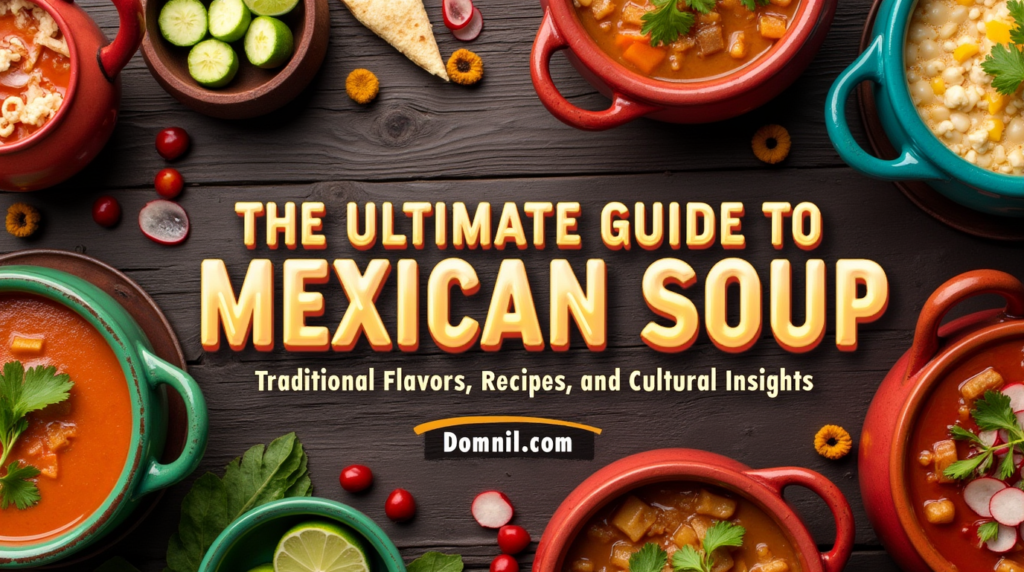
Table of Contents
The Cultural Roots of Soups in Mexican Cuisine
Dig deep into the roots of Mexican cuisine, and you’ll find that soup plays a sacred role. Way before fusion tacos and avocado everything, indigenous cultures like the Aztecs and Mayans were crafting their own soup recipes from corn (maíz), beans, chili, and squash—ingredients still prominent in many traditional soups today. With the Spanish conquest, new ingredients like pork, beef, and garlic found their way into the mix, giving birth to more robust, meaty versions.
In Mexican homes, soup isn’t just an appetizer—it’s often the main event. You’ll find entire meals structured around it. And unlike other cuisines where soups are more seasonal, Mexican soups are enjoyed all year long. They evolve with the seasons—lighter broths in summer, rich stews in winter.
Whether you’re sitting in a family kitchen in Oaxaca or dining at a street-side stall in Guadalajara, the moment that hot bowl is set in front of you, you’re connected to centuries of culture, love, and culinary heritage.
Essential Ingredients in Mexican Soups
Staples You’ll Find in Every Bowl
No matter what part of Mexico you’re in, certain ingredients seem to pop up in just about every pot of soup. First off, maíz (corn) is king—whether it’s ground, whole, or as hominy. You’ll see it starring in pozole, thickening broths, and even forming the base of masa dumplings.
Then there’s beans, which are the workhorses of many Mexican recipes. Black beans, pinto beans, and even fava beans add a hearty texture and earthy richness to vegetable soups and stews alike. Chilies—oh yes, the backbone of that signature smoky-spicy flavor—come in countless varieties like ancho, guajillo, pasilla, and chipotle. Each brings its own level of heat and depth.
Let’s not forget about onions, garlic, and tomatoes—this trifecta forms the base of many soups and is often roasted or charred beforehand to enhance the flavor. Then you’ve got lime, cilantro, epazote (a native herb with a pungent flavor), and avocado—not just for garnish, but essential to rounding out the experience.
Spices That Make Mexican Soup Unique
It’s not just about the heat—it’s about balance. Mexican soups often blend multiple spices and herbs to create broths that are layered and complex. Cumin offers an earthy undertone. Oregano, especially Mexican oregano, brings a citrusy brightness. Bay leaves, coriander, and even cloves find their way into certain regional recipes.
And while some soups simmer for hours to coax out flavor, others rely on a “sofrito” base—sauteed onions, garlic, and peppers—to give an instant punch of taste.
The use of dried chilies is an art form. They’re often toasted and rehydrated, then blended into a paste that serves as the heart of the soup. The difference between tossing in raw chili powder and properly preparing a chili paste? Night and day. That’s what gives Mexican soup its magic.
Popular Types of Mexican Soup
Pozole – The Hearty Hominy Classic
Let’s start with one of the absolute superstars of Mexican soup: Pozole. This ancient dish dates back to pre-Columbian times, originally made for ceremonial occasions by the Aztecs. Fast forward to today, and pozole is still celebrated as a rich, festive, and utterly delicious soup enjoyed during family gatherings, holidays like Christmas, or even just on a rainy weekend.
What makes pozole stand out? The hominy—big, puffy corn kernels that are soaked and boiled until they burst into a chewy, tender delight. Add to that a meaty protein (usually pork shoulder or chicken), and you’ve got a soup that eats like a full meal. The real flavor bomb comes from the red chili sauce, made by blending dried chilies (like guajillo and ancho) into a paste and mixing it into the broth.
Pozole comes in three main versions:
- Pozole Rojo (Red Pozole) – made with red chilies.
- Pozole Verde (Green Pozole) – featuring green chilies, tomatillos, and herbs.
- Pozole Blanco (White Pozole) – no added chili, keeping it simple and mild.
The best part? The toppings. Shredded cabbage, radish slices, diced onions, lime wedges, avocado, and crunchy tostadas all go on top, giving you a blend of flavors and textures in every spoonful. It’s like a customizable party in a bowl.
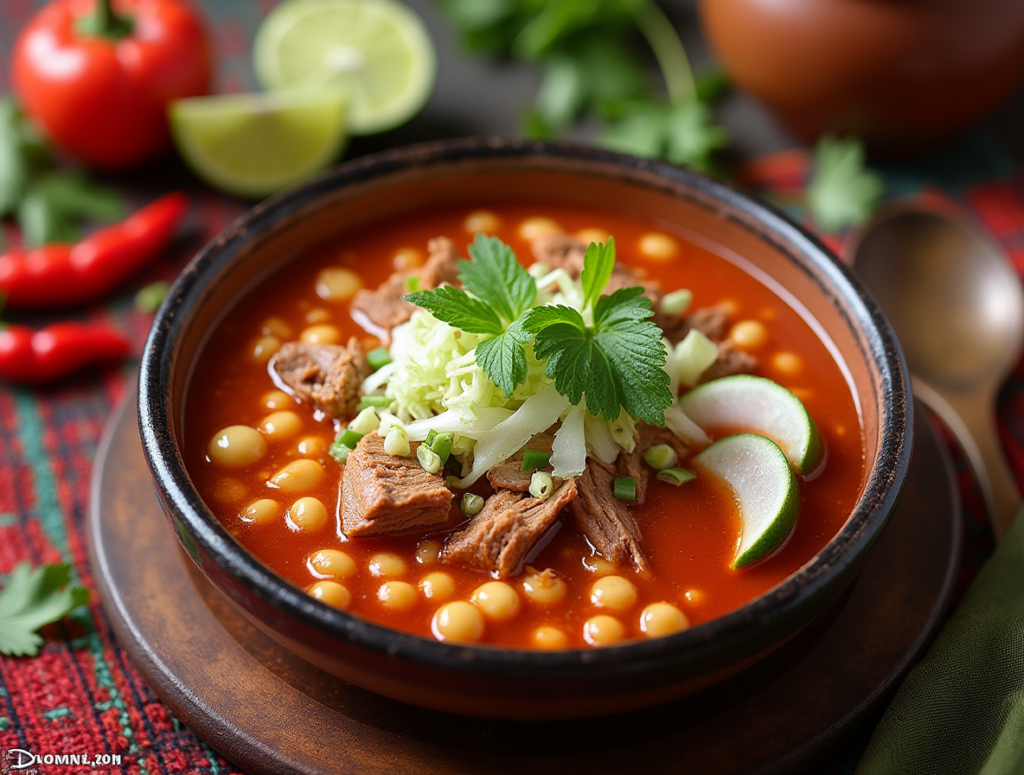
Menudo – The Ultimate Hangover Cure
Let’s be honest—Menudo isn’t for everyone. But for those who love it, it’s everything. Made from beef tripe (yes, the stomach lining), this soup has earned its spot as a weekend ritual, especially popular on Sundays. Why Sundays? Because menudo has a reputation as the ultimate hangover cure. And trust me, it’s not just folklore—this rich, steamy soup somehow brings you back to life.
The preparation takes time. The tripe is thoroughly cleaned, often soaked overnight, and then simmered for hours in a chili-laced broth until it becomes tender and absorbs all the deep, spicy flavors. It’s typically flavored with hominy, oregano, chili peppers, and lime. And like pozole, it’s served with fresh toppings: chopped onions, crushed chilies, lime juice, and warm tortillas on the side.
Menudo is also deeply symbolic in Mexican culture. It’s about resilience, community, and comfort. Whether you’re sipping it at a family table or slurping it in a bustling mercado, menudo makes you feel like everything’s going to be alright.
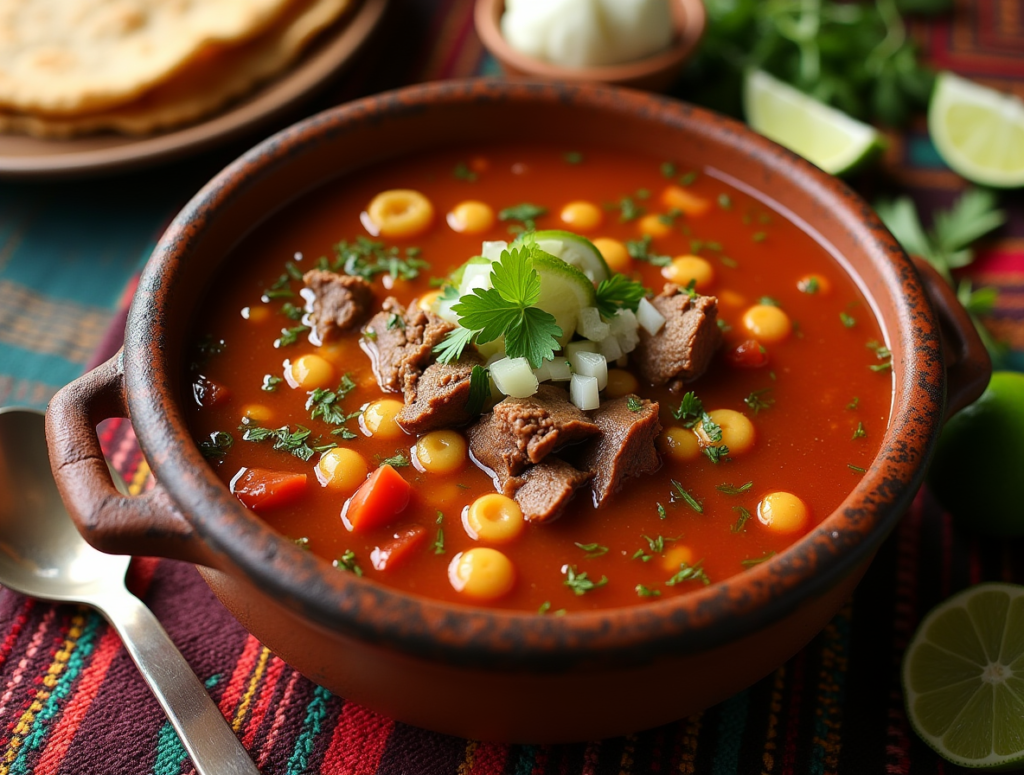
Sopa de Tortilla – Crunchy, Creamy, Spicy
Sopa de tortilla—aka tortilla soup—is a beloved staple that’s both humble and elegant. At its core, it’s a tomato-based broth infused with garlic, onion, and dried chilies (usually pasilla). What sets it apart is the crispy strips of fried corn tortillas that are either stirred into the broth or served on top for added crunch.
But it doesn’t stop there. Sopa de tortilla is often garnished with a swirl of crema, avocado slices, crumbled queso fresco, and sometimes shredded chicken. The balance between the rich, smoky broth and the creamy, crunchy toppings is downright addictive.
It’s the kind of soup that warms you up without weighing you down. Perfect as a light dinner, a starter before a big meal, or even a cozy lunch. And it’s ridiculously easy to make at home with pantry staples—plus, it’s a great way to use up leftover tortillas.

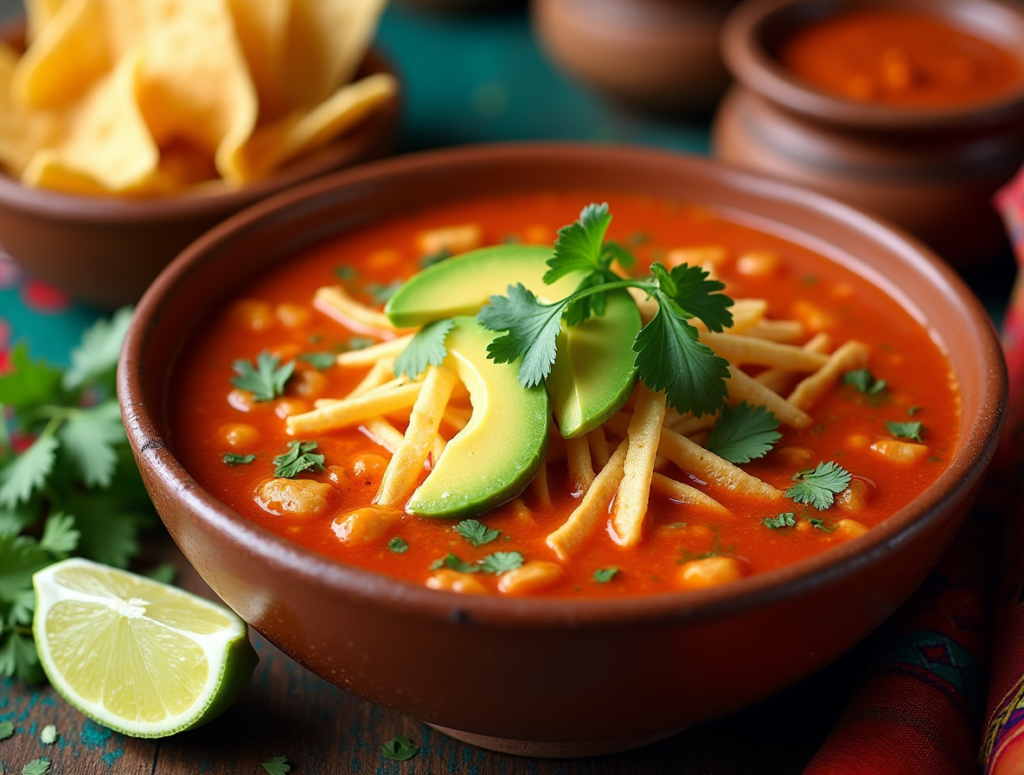
Caldo de Res – The Mexican Beef Stew
This is comfort food at its finest. Caldo de res, or Mexican beef soup, is a rustic, wholesome dish that’s as hearty as they come. Imagine chunks of beef shank with bone, simmering slowly in a pot with large pieces of carrots, potatoes, corn on the cob, zucchini, and cabbage—it’s like a complete Sunday dinner in one bowl.
The broth is clear but deeply flavorful, thanks to hours of simmering and a few key seasonings like bay leaves, garlic, and cilantro. Unlike creamy Western stews, caldo de res keeps things light and brothy, allowing the natural taste of each ingredient to shine through.
And again—don’t forget the garnishes. A squeeze of lime, a pinch of salt, and maybe a splash of hot sauce, plus a side of rice or tortillas, take this dish to the next level. It’s grandma’s hug in soup form.

Vegetarian and Vegan Mexican Soups
Plant-Based Takes on Classic Recipes
You don’t have to be a carnivore to enjoy the vibrant world of Mexican soups. There are plenty of vegetarian and vegan versions that pack just as much flavor. Thanks to the abundance of fresh veggies, herbs, beans, and spices in Mexican cuisine, going meatless is easier—and tastier—than ever.
Take Sopa de Lentejas (lentil soup), for example. It’s protein-packed, hearty, and loaded with vegetables like carrots, celery, and potatoes. With the addition of cumin and fresh cilantro, it has a smoky warmth that’ll surprise you.
Then there’s caldo tlalpeño, which can easily be made vegan by replacing the chicken with chickpeas or jackfruit. Or tortilla soup, where you can skip the chicken and cheese and load up on avocado and crispy tortilla strips instead.
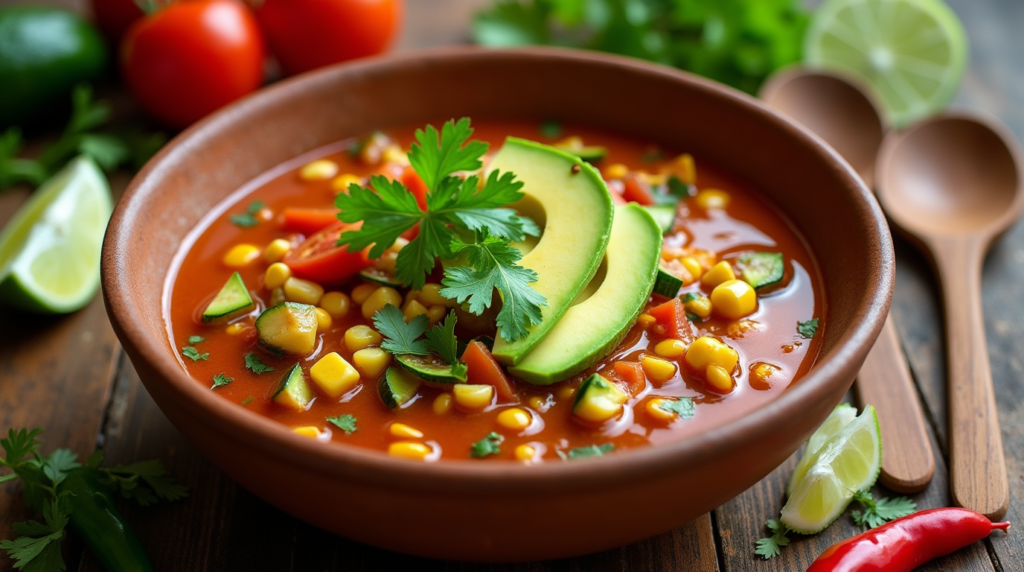
Ingredients to Watch For and Swap Out
If you’re sticking to a plant-based lifestyle, there are a few ingredients to watch out for. Traditional broths may be meat-based, so opt for vegetable stock or make your own. Keep an eye on garnishes like sour cream and cheese, which can be replaced with vegan alternatives like cashew cream or nutritional yeast.
Here’s a quick table of common swaps:
| Traditional Ingredient | Plant-Based Alternative |
|---|---|
| Chicken or Beef Stock | Vegetable broth |
| Cheese (queso fresco) | Vegan cheese / nutritional yeast |
| Sour Cream | Vegan sour cream / cashew crema |
| Chicken | Jackfruit, mushrooms, chickpeas |
The goal is to preserve the flavor while keeping things clean and green. And the good news? Mexican soups are incredibly flexible. You can play with seasonings, add hearty grains like quinoa, and still get that rich, bold taste you crave.
Regional Variations of Mexican Soups
Northern vs. Southern Mexican Soup Styles
If you think all Mexican soups are the same, think again. One of the most exciting things about exploring Mexican soup is discovering how diverse it can be from region to region. Geography, climate, and cultural influences all shape the kinds of ingredients and cooking methods used in different parts of the country.
In Northern Mexico, the climate tends to be drier, and beef is more prevalent due to cattle ranching. Soups from this region often include hearty cuts of beef, like in caldo de res or carne en su jugo, a flavorful beef broth with beans, bacon, and green salsa. Northern soups also tend to be richer and more robust, perfect for the cooler desert nights.
In contrast, Southern Mexico—particularly states like Oaxaca and Chiapas—has a stronger Indigenous and tropical influence. You’ll find more vegetarian options, complex spice blends, and regional herbs like epazote or hoja santa. Soups like caldo de camarón (shrimp soup) and sopa de guías (a soup made with squash vines and flowers) showcase the region’s agricultural abundance.
These regional differences not only highlight the diversity of Mexican cuisine but also give us more reasons to fall in love with it. Every bowl tells a different story, and each region puts its own delicious twist on tradition.
Coastal Flavors vs. Mountain Traditions
Travel to the coastal regions of Mexico, and the soups take on a completely different personality. Seafood is king here, and soups often feature fresh catches straight from the ocean. One standout is caldo de mariscos (seafood soup), a spicy, tomato-based broth brimming with shrimp, crab, octopus, and fish. It’s a celebration of the sea, often served with lime, hot sauce, and a cold cerveza on the side.
Then there’s chilpachole, a spicy seafood stew from Veracruz, rich with garlic, chilies, and tomato. It’s like the Mexican version of bouillabaisse, with a fiery kick.
In the mountain regions, where temperatures can dip significantly, soups are all about warmth and sustenance. Think thick broths, root vegetables, and smoky chilies. Soups like mole de olla combine beef with corn, squash, and nopales (cactus paddles) in a deeply spiced broth that warms you from the inside out.
These culinary contrasts between coastal and mountain regions show just how adaptable and diverse Mexican soups truly are—rooted in place, rich in flavor, and endlessly comforting.
Health Benefits of Mexican Soups
Nutritional Value of Traditional Ingredients
Mexican soups aren’t just delicious—they’re incredibly nourishing. Many traditional ingredients found in these soups are nutritional powerhouses that support overall health. For starters, hominy, a key ingredient in pozole, is high in fiber and B vitamins. It also provides slow-digesting carbs, which help keep you full and energized.
Beans—featured in lentil soup, frijoles charros, and other recipes—are packed with plant-based protein, iron, and soluble fiber. They’re great for heart health and digestion. Chilies, meanwhile, are rich in vitamin C, beta-carotene, and capsaicin, a compound known for its metabolism-boosting and anti-inflammatory properties.
Vegetables like carrots, squash, and zucchini, common in caldo de res and other brothy stews, provide essential vitamins and minerals. Add garlic and onions, which support immune health, and you’ve got yourself a superfood soup.
What’s more, many Mexican soups are low in fat and naturally gluten-free, making them suitable for a variety of diets. And let’s not forget that warm broth—whether veggie or meat-based—can soothe sore throats, ease digestion, and promote hydration.
Why Broth-Based Soups Are Good for You
There’s something magical about broth-based soups. They’re easy to digest, hydrating, and deeply satisfying without being heavy. Traditional Mexican broths—whether made with bones, vegetables, or seafood—are typically simmered for hours to extract nutrients and develop flavor.
Bone broth, for instance, is rich in collagen, gelatin, and minerals like calcium and magnesium. These compounds are believed to support joint health, skin elasticity, and gut function. Even plant-based broths offer minerals and antioxidants, especially when made with a colorful array of vegetables and herbs.
Broth-based soups are also great for weight management, as they tend to be low in calories but high in volume—meaning they fill you up without overloading your plate. And when you add fiber-rich ingredients like legumes or corn, you get the perfect combo of taste, satisfaction, and nutrition.
In short, a steaming bowl of Mexican soup is more than just comfort food—it’s a nutritional gift.
Cooking Techniques for the Perfect Soup
Tips for Depth of Flavor
Ever wonder how abuelitas make their soups taste like magic? It’s all about the techniques. One of the biggest secrets to deep, layered flavor is the use of roasting and toasting. Roasting tomatoes, garlic, and chilies before blending them into a broth brings out their natural sweetness and intensifies the flavor. Toasting dried chilies enhances their aroma and reduces bitterness.
Another tip? Don’t rush the sauté. Browning onions, garlic, and spices in oil before adding liquid creates a flavorful base called a sofrito. Think of it as building the foundation for your soup—skip this, and you’re starting with a weak base.
Also, layer your ingredients by cooking time. Add dense vegetables like carrots and potatoes early, and save delicate items like zucchini and leafy greens for the final minutes to prevent overcooking.
Use bone-in meats when possible, as they add flavor and richness to the broth. And don’t forget to skim the foam off the top of the pot while simmering—this keeps your broth clear and clean-tasting.
How Long to Simmer, When to Add What
Timing is everything when it comes to soup. Simmering slowly and patiently is the key to unlocking flavors. For meat-based soups, a simmer time of 1.5 to 3 hours is ideal, depending on the cut. This breaks down connective tissues and infuses the broth with deep, meaty flavor.
Here’s a general guide:
- Start with aromatics: onions, garlic, spices (saute 5-10 minutes)
- Add liquids and tough ingredients: meat, hard vegetables, dried chilies (simmer 1–2 hours)
- Add medium-soft ingredients: corn, beans, cabbage (30–45 minutes before serving)
- Finish with soft or fresh items: zucchini, cilantro, lime, avocado (last 10 minutes or as garnish)
Following this sequence ensures every ingredient is cooked to perfection, adding to the overall harmony of the dish.
Mexican Soup in Modern Cuisine
Fusion Dishes and Contemporary Twists
As much as we love tradition, Mexican soups aren’t stuck in the past. Modern chefs are getting creative, blending authentic recipes with global techniques and ingredients. These fusion soups are showing up in restaurants all over the world—and they’re just as delicious as the originals.
Take tortilla soup with roasted poblano crema or pozole ramen—yes, that’s a thing! Imagine ramen noodles soaking up the deep, chili-rich broth of pozole rojo, topped with shredded pork, avocado, and lime. It’s a cross-cultural flavor explosion that feels both familiar and new.
Even vegan and vegetarian twists are becoming more inventive. Think mushroom menudo, where earthy mushrooms replace tripe, or sopa de elote (corn soup) turned into a creamy bisque with coconut milk and jalapeño oil.
Food trucks and upscale eateries alike are giving these classics a modern edge, proving that Mexican soups are endlessly versatile. Whether you’re sticking with the old-school recipes or experimenting with the new, there’s no wrong way to soup.
Mexican Soup in Global Food Culture
Thanks to globalization and food media, Mexican soups have found their way into kitchens and menus around the globe. People are now craving authentic flavors with a homemade feel, and Mexican soups hit that comfort-food sweet spot.
Cooking shows, YouTube channels, and recipe blogs have introduced international audiences to the magic of dishes like caldo de pollo, sopa Azteca, and caldo tlalpeño. Mexican restaurants across the U.S., Canada, Europe, and Asia are adding these soul-warming soups to their menus—not just tacos and burritos anymore.
In fact, the demand for traditional Mexican cooking classes and home-style recipes has surged, with many chefs teaching the secrets of their family recipes to global fans. It’s a culinary movement rooted in flavor, community, and culture.
Serving and Pairing Ideas
Best Sides and Toppings
A good soup is great—but a great soup with the right toppings and sides? That’s legendary. Mexican soups are all about customization. A bowl of pozole isn’t complete without a lineup of shredded lettuce, chopped radish, diced onions, lime wedges, oregano, and crushed tostadas.
Here are some perfect pairings:
- Caldo de res: Serve with white rice, warm corn tortillas, and a squeeze of lime.
- Sopa de tortilla: Top with avocado, crema, crumbled cheese, and fried tortilla strips.
- Menudo: Best enjoyed with fresh cilantro, lime, chopped onion, and bolillo bread for dipping.
- Sopa de fideo: Goes great with pan dulce or quesadillas for a cozy meal.
It’s all about building layers—hot, cold, soft, crunchy, tangy, spicy—all in one bowl. Don’t be afraid to make it your own!
Drink Pairings and Dessert Ideas
A rich soup needs the right drink to go with it. Traditionally, agua fresca (like horchata or tamarindo) makes a refreshing companion to spicy soups. Want something more grown-up? Try a Michelada or a cold Mexican lager with your caldo.
And don’t skip dessert! After a hearty soup, lighten things up with:
- Flan – smooth, creamy, and just the right amount of sweet.
- Churros – crunchy, cinnamon-sugar perfection.
- Arroz con leche – a warm, comforting rice pudding with hints of vanilla and cinnamon.
These additions round out the meal and give you the full Mexican dining experience.
Cooking Tools & Equipment
- Large Stock Pot / Soup Pot – Essential for simmering large batches of soups like pozole or caldo de res.
- Blender or Immersion Blender – Used for blending soups like sopa de tortilla or chile-based broths.
- Cast Iron Dutch Oven – Great for even heat distribution in slow-cooked soups.
- Ladle & Skimmer Set – For serving and removing foam or fat from broths.
- Strainer or Mesh Sieve – Useful for achieving smooth broths after blending.
Conclusion
Mexican soup is more than just food—it’s a story of culture, heritage, love, and resilience. Whether you’re diving into a rich bowl of pozole on a holiday, savoring the healing warmth of menudo after a long night, or whipping up a quick sopa de fideo for a weeknight dinner, each spoonful carries centuries of flavor and tradition.
What makes these soups truly special is their flexibility and soulful essence. They’re meant to be shared, customized, and celebrated. So next time you crave comfort or want to try something new, let a Mexican soup be your go-to dish.
Warm, nourishing, and endlessly adaptable, these bowls of joy have a way of bringing people together—one slurp at a time.
FAQs
1. What is the most popular Mexican soup?
Pozole is arguably the most popular Mexican soup, enjoyed nationwide and often served during celebrations and holidays.
2. Can I make Mexican soups vegetarian or vegan?
Absolutely! Use vegetable broth, plant-based proteins like beans or jackfruit, and dairy-free garnishes to adapt traditional recipes.
3. How spicy are Mexican soups typically?
It varies—some are mild like caldo de pollo, while others, like menudo or seafood soups, can be quite spicy depending on the chilies used.
4. What’s the best soup for beginners to cook?
Sopa de fideo or tortilla soup are great starting points—they’re simple, fast, and don’t require hard-to-find ingredients.
5. Are there cold Mexican soups?
While most Mexican soups are served hot, some regions offer cold soups like gazpacho-style fruit soups or aguachile, a cold shrimp dish in lime and chili sauce.

